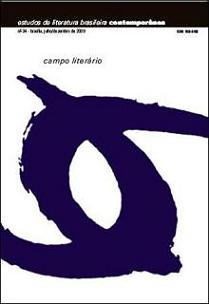A escrita comovida de João Anzanello Carrascoza
Abstract
A narração impassível, que emula em sua indiferença a brutalidade dos episódios descritos, caracteriza as ficções de mais visibilidade crítica e midiática na produção literária brasileira dos anos 1990. A atenção recebida por esse realismo mimético, que aposta no choque como estratégia de apreensão imediata do real, contribui para a criação de um contexto em que a narração comovida é percebida como ingênua, ou suspeita. A recepção dos contos de João Anzanello Carrascoza, descritos como fronteiriços entre o sublime e o kitsch, é um exemplo disso. Mas, nessas histórias, a comoção não resulta de uma negação do real, e sim do reconhecimento daquilo que ele tem de inelutável e “idiota”, como disse Clément Rosset.
Downloads
References
CARRASCOZA, João Anzanello. Hotel solidão. São Paulo: Scritta, 1994.
_______. O vaso azul. São Paulo: Ática, 1998.
_______. Duas tardes. São Paulo: Boitempo, 2002.
_______. Meu amigo João. São Paulo: Melhoramentos, 2003.
_______. Dias raros. São Paulo: Planeta, 2004.
_______. O volume do silêncio. São Paulo: Cosac Naify, 2006.
DERRIDA, Jacques. “How to avoid speaking”, em Iser, Wolfgang e Budick, Sanfoor. Languages of the unsayable. Stanford: Columbia Univeristy Press, 1987.
DUTTON, Dennis. “Kitsch”, em Turner, J. (coord.). The dictionary of art. Londres: Macmillan, 1998.
ECO, Umberto. Apocalípticos e integrados. Trad. de Pérola de Carvalho. Rio de Janeiro: Perspectiva, 1970.
JAGUARIBE, Beatriz. O choque do real. Rio de Janeiro: Rocco, 2007.
KUNDERA, Milan. A insustentável leveza do ser. Trad. de Teresa Bulhões Carvalho da Fonseca. São Paulo: Companhia das Letras, 2008.
ROSSET, Clément. O real e seu duplo. Trad. de José Thomaz Brum. Rio de Janeiro: José Olympio, 2007.
SCHOLLHAMMER, Karl Erik. “O espetáculo e a demanda do real”, em Freire Filho, João Batista de Macedo. Comunicação, cultura, consumo. Rio de Janeiro: e-papers, 2005. pp. 207-24.
SONTAG, Susan. “Notes on ‘Camp’”. Disponível em: . Acesso em: 09 nov. 2008.
Downloads
Published
How to Cite
Issue
Section
License
Authors who publish in this journal agree to the following terms:
a) The authors maintain the copyright and grant the journal the right of first publication, the work being simultaneously licensed under the Creative Commons Attribution License-Non Commercial 4.0 which allows the sharing of the work with acknowledgment of the authorship of the work and publication this journal.
b) Authors are authorized to enter into additional contracts separately, for non-exclusive distribution of the version of the work published in this journal (eg publish in institutional repository or as a book chapter), with authorship recognition and publication in this journal.
c) Authors are allowed and encouraged to publish and distribute their work online (eg in institutional repositories or on their personal page) after the editorial process, as this can generate productive changes, as well as increase the impact and citation of published work (See The Effect of Free Access).
d) The authors of the approved works authorize the magazine to, after publication, transfer its content for reproduction in content crawlers, virtual libraries and the like.
e) The authors assume that the texts submitted to the publication are of their original creation, being fully responsible for their content in the event of possible opposition by third parties.


